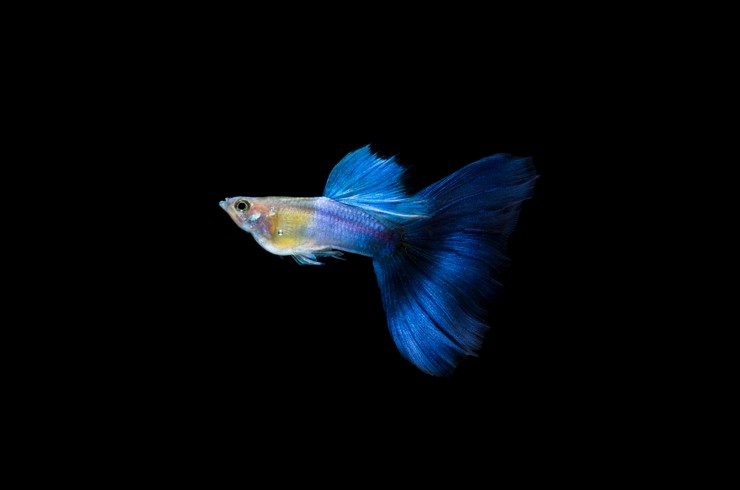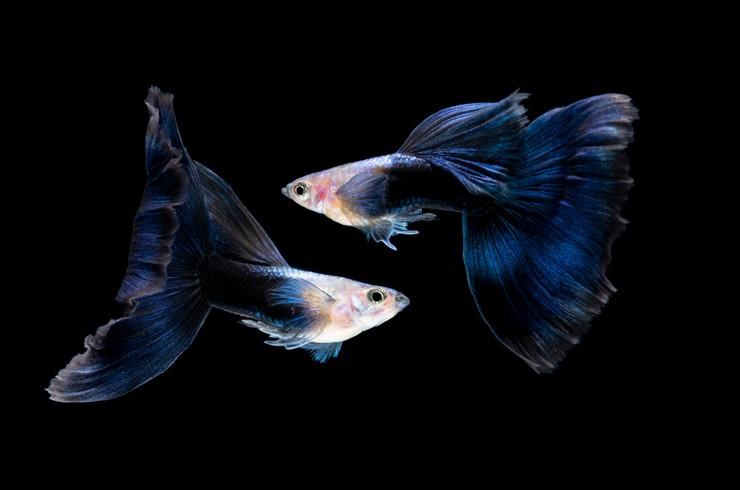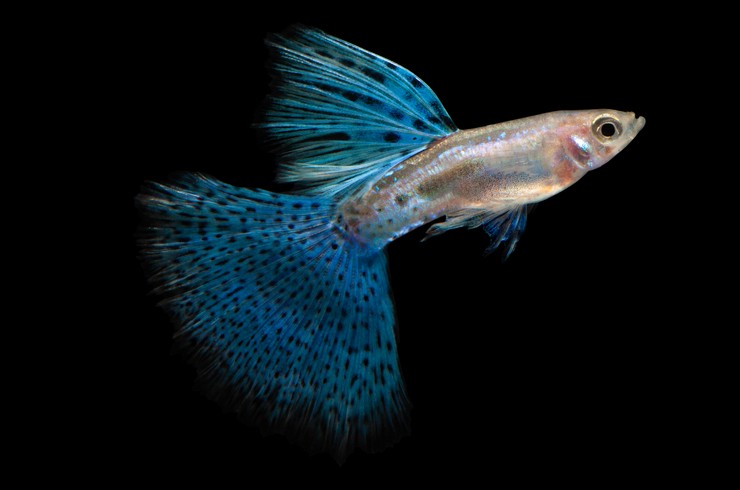The popularity of guppy fish among breeders can only be compared with the popularity of goldfish. But guppies have an incomparable advantage – they are viviparous, already fully formed fry are born. This improves the survival rate of babies. Thanks to the hard work of amateurs and professionals, a huge color variety of representatives of this species have been obtained. In our article, we will tell you about blue shapes.
General information
Blue guppies are a collective group of varieties of the common guppy (Poecilia reticulata), a distinctive feature of which is the predominance of blue or blue shades. Coloring can be either monochromatic or partial, sometimes with spots or in combination with other colors. Moscow guppies are often referred to as blue guppies (according to European criteria), which we described in a separate article.
Blue guppies are a great choice for beginner hobbyists. These are unpretentious fish to care for, they adapt well to various water parameters. Guppies reproduce incredibly easily, sometimes you don’t even need to make an effort to do this.
Appearance
Blue guppies are characterized by pronounced gender dimorphism. At first, it may even seem that there are two different species sitting in an aquarium with guppies, so significant are the differences. Male guppies do not grow more than 3 cm, they have a short body with an elegant tail fin. The color of males is very bright. Females, on the other hand, grow twice as large, they have a convex abdomen, a pale color, and a less expressive tail. The main gender difference is the presence of a modified anal fin in males – gonopodia. It resembles a tube in shape.
The life span of blue guppies depends greatly on the temperature of the water. If you keep it at a moderate level (24-26 ° C), then guppies will easily live 3-4 years. At higher temperatures, the metabolism of fish accelerates, but guppies live much shorter.
Habitat
Blue guppies were obtained artificially, so it will not work to meet them in nature. But thanks to mass reproduction by amateurs and on special fish farms, this form can be acquired by aquarists around the world.
The homeland of the common guppy – the parent form – is the reservoirs of South and Central America, as well as the islands of the Caribbean.
Care and maintenance
The optimal aquarium volume for blue guppies starts at 50 liters. A group of 6-9 fish can be kept here. It is important to observe the gender composition: there should be two or three females per male. The aquarium should be equipped with a lid because blue guppies can jump out of the water.
It is best to design an aquarium in a natural style using natural stones, driftwood, and living plants. Sand and small pebbles are usually chosen as soil. It is useful to put floating plants into the aquarium and plant popular mosses on driftwood. They will serve as a refuge for fry, which will certainly appear in the presence of a pair of fish.
Blue guppies love clean, oxygenated water, so be sure to install a filter and aeration system in your aquarium. The thermostat will allow you to maintain a comfortable temperature for the fish.
Be sure to carry out comprehensive maintenance of the aquarium once a week: clean the walls, siphon the soil, rinse the filter sponge and replace 20% of the water with fresh water. The water must be prepared with the Tetra AquaSafe conditioner. It will instantly remove chlorine and heavy metals that are dangerous for fish, as well as add useful vitamins and protective colloids to the water.
Optimum water parameters for the content: T = 24-26 ° C, pH = 7.0-8.5, GH = 10-25.
Compatibility
The character of blue guppies is calm and peaceful. You can easily keep them with non-aggressive fish species such as zebrafish, tetras, neons, mollies, rasbora. Fish will get along well with corridors and thoracotomy.
Of course, you should not plant blue guppies with predatory aggressive species, they will perceive the live-bearer only as food. Also, goldfish or active barbs will not be the most successful neighbors.
If you like the variety of colors, then you can keep several guppy breeds in the same tank. But it is worth considering the fact that in such groups uncontrolled crossing is possible, and the offspring will turn out to be of different colors.
Feeding blue guppies
Blue guppies are small fish with small mouths that prefer to swim in the upper and middle layers of the aquarium. When kept at home, it is more convenient and safer to feed guppies with high-quality dry food. Live and frozen food can become a source of infection and do not contain the full range of nutrients and vitamins that fish need.
For guppy lovers, Tetra has created a specialized food – Tetra Guppy Mini Flakes. These mini flakes are ideal for all types of fish that feed near the surface of the water. The flake size is designed exclusively for fish with small mouths, making it easier to eat. A special nutrient complex will provide your fish with all the elements they need. The food supports the health and vitality of the fish.
Alternatively, you can use the classic TetraMin Flakes or one of the Tetra Micro Foods.
And if you want to pamper your pets, then offer them natural treats in Tetra FreshDelica Nutritional Jelly.
Reproduction and breeding
For aquarists looking to breed from their pets, blue guppies are a godsend. Unlike most fish that lay eggs, guppies are viviparous. Fertilization of eggs occurs inside the body of the female, and fully formed fry are born, capable of feeding on their own.
For the role of producers, it is advisable to select the most beautiful and healthy individuals. Distinguishing a female from a male is very simple, you will find gonopodia only in a male. Spawning is possible in both general and individual aquariums. In the latter case, the offspring will be more numerous. In shared aquariums, there is a high risk of eating fry by both parents and other fish.
Under suitable conditions, the male begins to chase the female until she responds to his courtship. Then mating takes place: in this case, the male, with the help of the gonopodia, introduces his milk into the body of the female. Fertilization and development of eggs also take place there. It lasts (depending on temperature) from 21 to 40 days, after which fry up to 5 mm in size is born. The fertility of the female can range from 1 to 100 fry.

